2009 NISSAN VERSA HATCHBACK spare wheel
[x] Cancel search: spare wheelPage 20 of 55
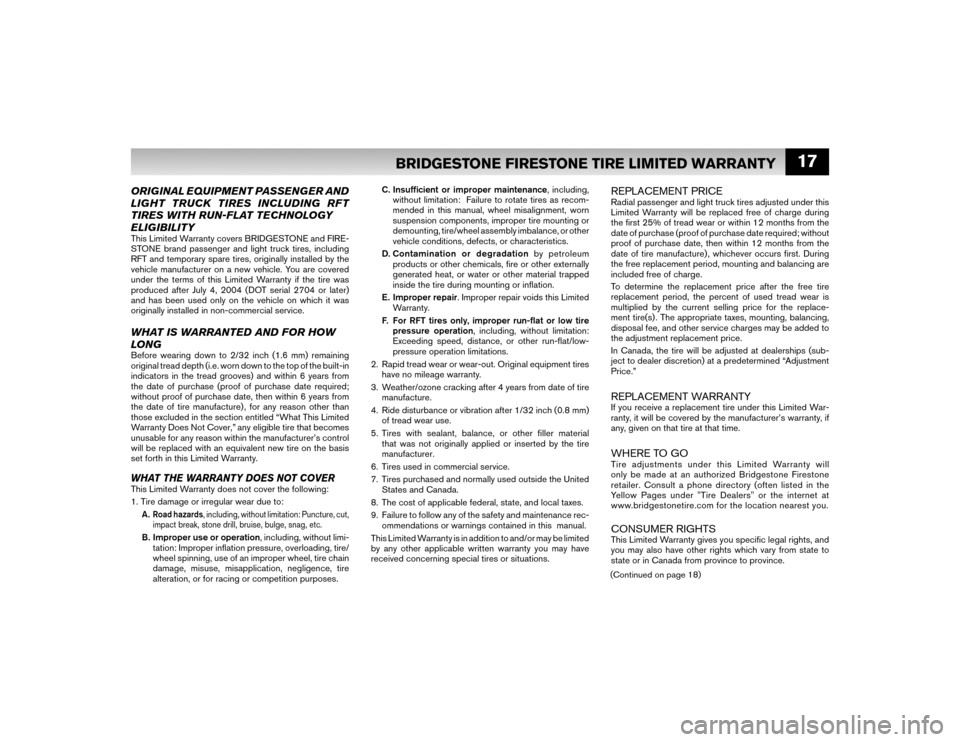
17
ORIGINAL EQUIPMENT PASSENGER AND
LIGHT TRUCK TIRES INCLUDING RFT
TIRES WITH RUN-FLAT TECHNOLOGY
ELIGIBILITYThis Limited Warranty covers BRIDGESTONE and FIRE-
STONE brand passenger and light truck tires, including
RFT and temporary spare tires, originally installed by the
vehicle manufacturer on a new vehicle. You are covered
under the terms of this Limited Warranty if the tire was
produced after July 4, 2004 (DOT serial 2704 or later)
and has been used only on the vehicle on which it was
originally installed in non-commercial service.WHAT IS WARRANTED AND FOR HOW
LONGBefore wearing down to 2/32 inch (1.6 mm) remaining
original tread depth (i.e. worn down to the top of the built-in
indicators in the tread grooves) and within 6 years from
the date of purchase (proof of purchase date required;
without proof of purchase date, then within 6 years from
the date of tire manufacture) , for any reason other than
those excluded in the section entitled “What This Limited
Warranty Does Not Cover,” any eligible tire that becomes
unusable for any reason within the manufacturer’s control
will be replaced with an equivalent new tire on the basis
set forth in this Limited Warranty.WHAT THE WARRANTY DOES NOT COVERThis Limited Warranty does not cover the following:
1. Tire damage or irregular wear due to:
A.
Road hazards, including, without limitation: Puncture, cut,
impact break, stone drill, bruise, bulge, snag, etc.B. Improper use or operation, including, without limi-
tation: Improper infl ation pressure, overloading, tire/
wheel spinning, use of an improper wheel, tire chain
damage, misuse, misapplication, negligence, tire
alteration, or for racing or competition purposes.C. Insuffi cient or improper maintenance, including,
without limitation: Failure to rotate tires as recom-
mended in this manual, wheel misalignment, worn
suspension components, improper tire mounting or
demounting, tire/wheel assembly imbalance, or other
vehicle conditions, defects, or characteristics.
D. Contamination or degradation by petroleum
products or other chemicals, fi re or other externally
generated heat, or water or other material trapped
inside the tire during mounting or infl ation.
E. Improper repair. Improper repair voids this Limited
Warranty.
F. For RFT tires only, improper run-fl at or low tire
pressure operation, including, without limitation:
Exceeding speed, distance, or other run-fl at/low-
pressure operation limitations.
2. Rapid tread wear or wear-out. Original equipment tires
have no mileage warranty.
3. Weather/ozone cracking after 4 years from date of tire
manufacture.
4. Ride disturbance or vibration after 1/32 inch (0.8 mm)
of tread wear use.
5. Tires with sealant, balance, or other fi ller material
that was not originally applied or inserted by the tire
manufacturer.
6. Tires used in commercial service.
7. Tires purchased and normally used outside the United
States and Canada.
8. The cost of applicable federal, state, and local taxes.
9. Failure to follow any of the safety and maintenance rec-
ommendations or warnings contained in this manual.
This Limited Warranty is in addition to and/or may be limited
by any other applicable written warranty you may have
received concerning special tires or situations.
REPLACEMENT PRICERadial passenger and light truck tires adjusted under this
Limited Warranty will be replaced free of charge during
the fi rst 25% of tread wear or within 12 months from the
date of purchase (proof of purchase date required; without
proof of purchase date, then within 12 months from the
date of tire manufacture) , whichever occurs fi rst. During
the free replacement period, mounting and balancing are
included free of charge.
To determine the replacement price after the free tire
replacement period, the percent of used tread wear is
multiplied by the current selling price for the replace-
ment tire(s) . The appropriate taxes, mounting, balancing,
disposal fee, and other service charges may be added to
the adjustment replacement price.
In Canada, the tire will be adjusted at dealerships (sub-
ject to dealer discretion) at a predetermined “Adjustment
Price.”REPLACEMENT WARRANTYIf you receive a replacement tire under this Limited War-
ranty, it will be covered by the manufacturer’s warranty, if
any, given on that tire at that time.WHERE TO GOTire adjustments under this Limited Warranty will
only be made at an authorized Bridgestone Firestone
retailer. Consult a phone directory (often listed in the
Yellow Pages under "Tire Dealers" or the internet at
www.bridgestonetire.com for the location nearest you.CONSUMER RIGHTSThis Limited Warranty gives you specifi c legal rights, and
you may also have other rights which vary from state to
state or in Canada from province to province.
BRIDGESTONE FIRESTONE TIRE LIMITED WARRANTY
(Continued on page 18)
Page 23 of 55
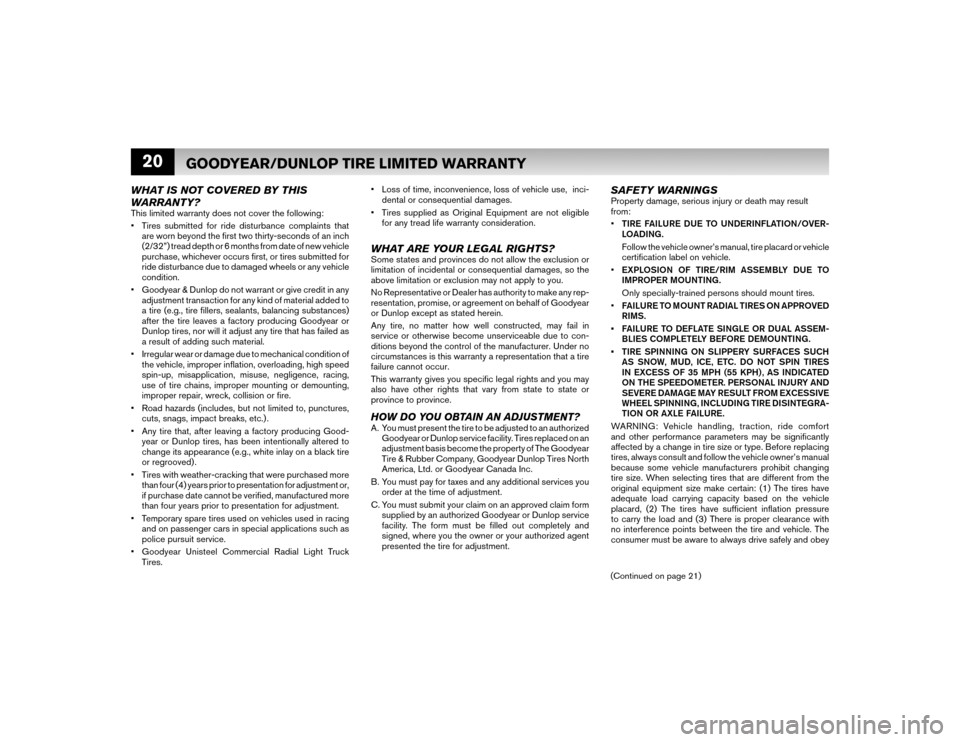
20
GOODYEAR/DUNLOP TIRE LIMITED WARRANTY
WHAT IS NOT COVERED BY THIS
WARRANTY?This limited warranty does not cover the following:
• Tires submitted for ride disturbance complaints that
are worn beyond the fi rst two thirty-seconds of an inch
(2/32”) tread depth or 6 months from date of new vehicle
purchase, whichever occurs fi rst, or tires submitted for
ride disturbance due to damaged wheels or any vehicle
condition.
• Goodyear & Dunlop do not warrant or give credit in any
adjustment transaction for any kind of material added to
a tire (e.g., tire fi llers, sealants, balancing substances)
after the tire leaves a factory producing Goodyear or
Dunlop tires, nor will it adjust any tire that has failed as
a result of adding such material.
• Irregular wear or damage due to mechanical condition of
the vehicle, improper infl ation, overloading, high speed
spin-up, misapplication, misuse, negligence, racing,
use of tire chains, improper mounting or demounting,
improper repair, wreck, collision or fi re.
• Road hazards (includes, but not limited to, punctures,
cuts, snags, impact breaks, etc.) .
• Any tire that, after leaving a factory producing Good-
year or Dunlop tires, has been intentionally altered to
change its appearance (e.g., white inlay on a black tire
or regrooved) .
• Tires with weather-cracking that were purchased more
than four (4) years prior to presentation for adjustment or,
if purchase date cannot be verifi ed, manufactured more
than four years prior to presentation for adjustment.
• Temporary spare tires used on vehicles used in racing
and on passenger cars in special applications such as
police pursuit service.
• Goodyear Unisteel Commercial Radial Light Truck
Tires.• Loss of time, inconvenience, loss of vehicle use, inci-
dental or consequential damages.
• Tires supplied as Original Equipment are not eligible
for any tread life warranty consideration.
WHAT ARE YOUR LEGAL RIGHTS?Some states and provinces do not allow the exclusion or
limitation of incidental or consequential damages, so the
above limitation or exclusion may not apply to you.
No Representative or Dealer has authority to make any rep-
resentation, promise, or agreement on behalf of Goodyear
or Dunlop except as stated herein.
Any tire, no matter how well constructed, may fail in
service or otherwise become unserviceable due to con-
ditions beyond the control of the manufacturer. Under no
circumstances is this warranty a representation that a tire
failure cannot occur.
This warranty gives you specifi c legal rights and you may
also have other rights that vary from state to state or
province to province.HOW DO YOU OBTAIN AN ADJUSTMENT?A. You must present the tire to be adjusted to an authorized
Goodyear or Dunlop service facility. Tires replaced on an
adjustment basis become the property of The Goodyear
Tire & Rubber Company, Goodyear Dunlop Tires North
America, Ltd. or Goodyear Canada Inc.
B. You must pay for taxes and any additional services you
order at the time of adjustment.
C. You must submit your claim on an approved claim form
supplied by an authorized Goodyear or Dunlop service
facility. The form must be fi lled out completely and
signed, where you the owner or your authorized agent
presented the tire for adjustment.
SAFETY WARNINGSProperty damage, serious injury or death may result
from:
• TIRE FAILURE DUE TO UNDERINFLATION/OVER-
LOADING.
Follow the vehicle owner’s manual, tire placard or vehicle
certifi cation label on vehicle.
• EXPLOSION OF TIRE/RIM ASSEMBLY DUE TO
IMPROPER MOUNTING.
Only specially-trained persons should mount tires.
• FAILURE TO MOUNT RADIAL TIRES ON APPROVED
RIMS.
• FAILURE TO DEFLATE SINGLE OR DUAL ASSEM-
BLIES COMPLETELY BEFORE DEMOUNTING.
• TIRE SPINNING ON SLIPPERY SURFACES SUCH
AS SNOW, MUD, ICE, ETC. DO NOT SPIN TIRES
IN EXCESS OF 35 MPH (55 KPH) , AS INDICATED
ON THE SPEEDOMETER. PERSONAL INJURY AND
SEVERE DAMAGE MAY RESULT FROM EXCESSIVE
WHEEL SPINNING, INCLUDING TIRE DISINTEGRA-
TION OR AXLE FAILURE.
WARNING: Vehicle handling, traction, ride comfort
and other performance parameters may be signifi cantly
affected by a change in tire size or type. Before replacing
tires, always consult and follow the vehicle owner’s manual
because some vehicle manufacturers prohibit changing
tire size. When selecting tires that are different from the
original equipment size make certain: (1) The tires have
adequate load carrying capacity based on the vehicle
placard, (2) The tires have suffi cient infl ation pressure
to carry the load and (3) There is proper clearance with
no interference points between the tire and vehicle. The
consumer must be aware to always drive safely and obey (Continued on page 21)
Page 25 of 55
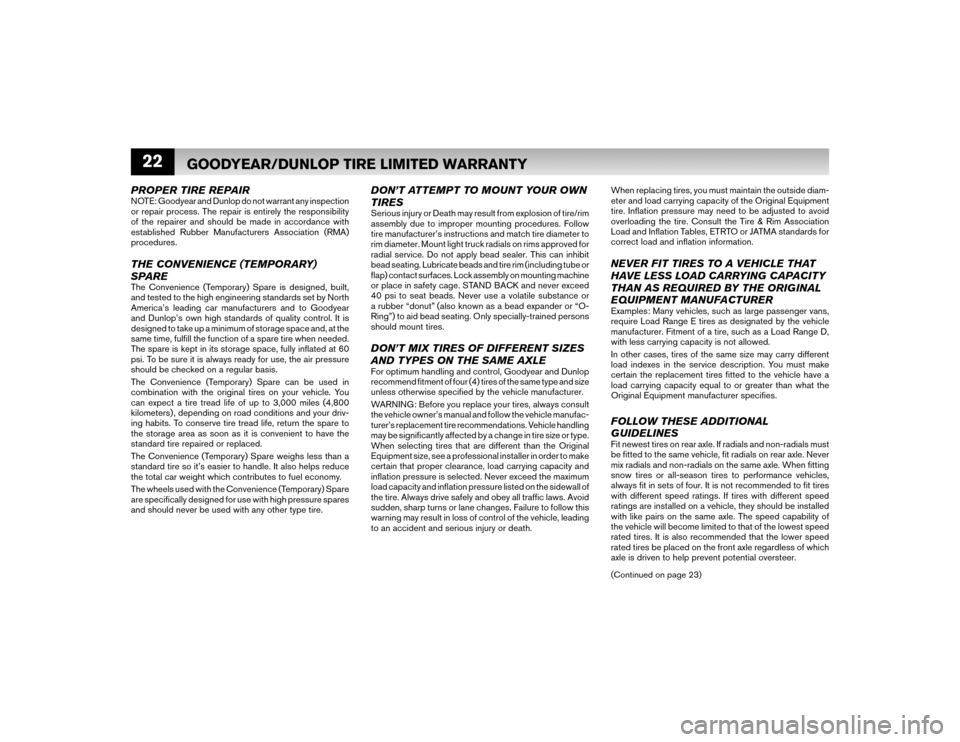
22PROPER TIRE REPAIRNOTE: Goodyear and Dunlop do not warrant any inspection
or repair process. The repair is entirely the responsibility
of the repairer and should be made in accordance with
established Rubber Manufacturers Association (RMA)
procedures.THE CONVENIENCE (TEMPORARY)
SPAREThe Convenience (Temporary) Spare is designed, built,
and tested to the high engineering standards set by North
America’s leading car manufacturers and to Goodyear
and Dunlop’s own high standards of quality control. It is
designed to take up a minimum of storage space and, at the
same time, fulfi ll the function of a spare tire when needed.
The spare is kept in its storage space, fully infl ated at 60
psi. To be sure it is always ready for use, the air pressure
should be checked on a regular basis.
The Convenience (Temporary) Spare can be used in
combination with the original tires on your vehicle. You
can expect a tire tread life of up to 3,000 miles (4,800
kilometers) , depending on road conditions and your driv-
ing habits. To conserve tire tread life, return the spare to
the storage area as soon as it is convenient to have the
standard tire repaired or replaced.
The Convenience (Temporary) Spare weighs less than a
standard tire so it’s easier to handle. It also helps reduce
the total car weight which contributes to fuel economy.
The wheels used with the Convenience (Temporary) Spare
are specifi cally designed for use with high pressure spares
and should never be used with any other type tire.
GOODYEAR/DUNLOP TIRE LIMITED WARRANTY
DON’T ATTEMPT TO MOUNT YOUR OWN
TIRESSerious injury or Death may result from explosion of tire/rim
assembly due to improper mounting procedures. Follow
tire manufacturer’s instructions and match tire diameter to
rim diameter. Mount light truck radials on rims approved for
radial service. Do not apply bead sealer. This can inhibit
bead seating. Lubricate beads and tire rim (including tube or
fl ap) contact surfaces. Lock assembly on mounting machine
or place in safety cage. STAND BACK and never exceed
40 psi to seat beads. Never use a volatile substance or
a rubber “donut” (also known as a bead expander or “O-
Ring”) to aid bead seating. Only specially-trained persons
should mount tires.DON’T MIX TIRES OF DIFFERENT SIZES
AND TYPES ON THE SAME AXLEFor optimum handling and control, Goodyear and Dunlop
recommend fi tment of four (4) tires of the same type and size
unless otherwise specifi ed by the vehicle manufacturer.
WARNING: Before you replace your tires, always consult
the vehicle owner’s manual and follow the vehicle manufac-
turer’s replacement tire recommendations. Vehicle handling
may be signifi cantly affected by a change in tire size or type.
When selecting tires that are different than the Original
Equipment size, see a professional installer in order to make
certain that proper clearance, load carrying capacity and
infl ation pressure is selected. Never exceed the maximum
load capacity and infl ation pressure listed on the sidewall of
the tire. Always drive safely and obey all traffi c laws. Avoid
sudden, sharp turns or lane changes. Failure to follow this
warning may result in loss of control of the vehicle, leading
to an accident and serious injury or death. When replacing tires, you must maintain the outside diam-
eter and load carrying capacity of the Original Equipment
tire. Infl ation pressure may need to be adjusted to avoid
overloading the tire. Consult the Tire & Rim Association
Load and Infl ation Tables, ETRTO or JATMA standards for
correct load and infl ation information.
NEVER FIT TIRES TO A VEHICLE THAT
HAVE LESS LOAD CARRYING CAPACITY
THAN AS REQUIRED BY THE ORIGINAL
EQUIPMENT MANUFACTURERExamples: Many vehicles, such as large passenger vans,
require Load Range E tires as designated by the vehicle
manufacturer. Fitment of a tire, such as a Load Range D,
with less carrying capacity is not allowed.
In other cases, tires of the same size may carry different
load indexes in the service description. You must make
certain the replacement tires fi tted to the vehicle have a
load carrying capacity equal to or greater than what the
Original Equipment manufacturer specifi es.FOLLOW THESE ADDITIONAL
GUIDELINESFit newest tires on rear axle. If radials and non-radials must
be fi tted to the same vehicle, fi t radials on rear axle. Never
mix radials and non-radials on the same axle. When fi tting
snow tires or all-season tires to performance vehicles,
always fi t in sets of four. It is not recommended to fi t tires
with different speed ratings. If tires with different speed
ratings are installed on a vehicle, they should be installed
with like pairs on the same axle. The speed capability of
the vehicle will become limited to that of the lowest speed
rated tires. It is also recommended that the lower speed
rated tires be placed on the front axle regardless of which
axle is driven to help prevent potential oversteer.(Continued on page 23)
Page 26 of 55
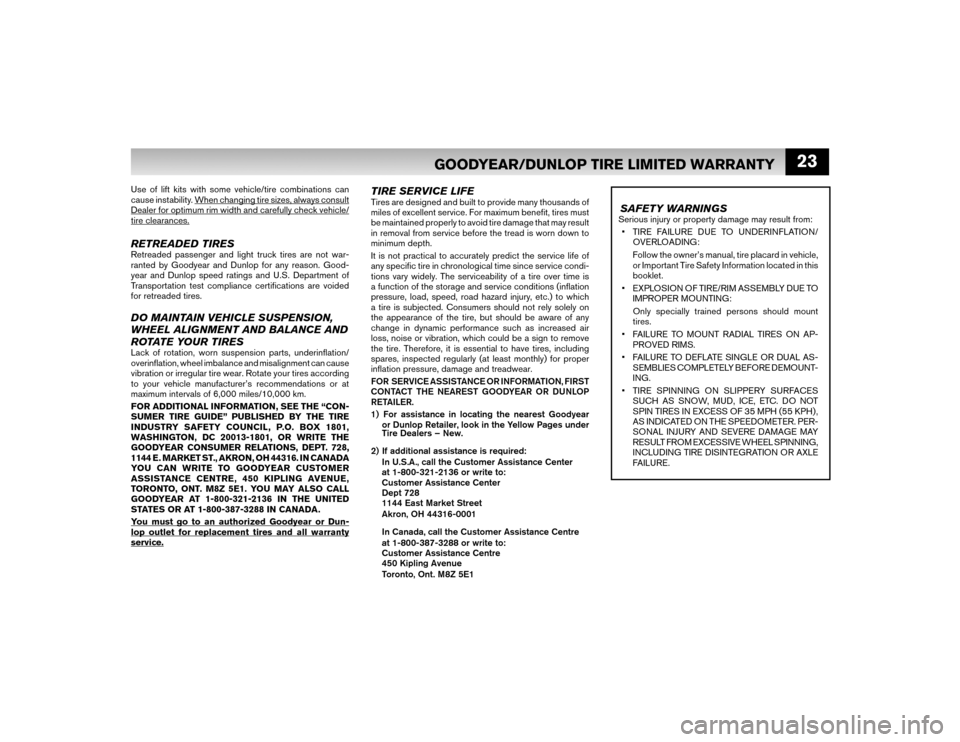
23
GOODYEAR/DUNLOP TIRE LIMITED WARRANTY
Use of lift kits with some vehicle/tire combinations can
cause instability. When changing tire sizes, always consult
Dealer for optimum rim width and carefully check vehicle/
tire clearances.RETREADED TIRESRetreaded passenger and light truck tires are not war-
ranted by Goodyear and Dunlop for any reason. Good-
year and Dunlop speed ratings and U.S. Department of
Transportation test compliance certifi cations are voided
for retreaded tires.DO MAINTAIN VEHICLE SUSPENSION,
WHEEL ALIGNMENT AND BALANCE AND
ROTATE YOUR TIRESLack of rotation, worn suspension parts, underinfl ation/
overinfl ation, wheel imbalance and misalignment can cause
vibration or irregular tire wear. Rotate your tires according
to your vehicle manufacturer’s recommendations or at
maximum intervals of 6,000 miles/10,000 km.
FOR ADDITIONAL INFORMATION, SEE THE “CON-
SUMER TIRE GUIDE” PUBLISHED BY THE TIRE
INDUSTRY SAFETY COUNCIL, P.O. BOX 1801,
WASHINGTON, DC 20013-1801, OR WRITE THE
GOODYEAR CONSUMER RELATIONS, DEPT. 728,
1144 E. MARKET ST., AKRON, OH 44316. IN CANADA
YOU CAN WRITE TO GOODYEAR CUSTOMER
ASSISTANCE CENTRE, 450 KIPLING AVENUE,
TORONTO, ONT. M8Z 5E1. YOU MAY ALSO CALL
GOODYEAR AT 1-800-321-2136 IN THE UNITED
STATES OR AT 1-800-387-3288 IN CANADA.
You must go to an authorized Goodyear or Dun-
lop outlet for replacement tires and all warranty
service.
TIRE SERVICE LIFETires are designed and built to provide many thousands of
miles of excellent service. For maximum benefi t, tires must
be maintained properly to avoid tire damage that may result
in removal from service before the tread is worn down to
minimum depth.
It is not practical to accurately predict the service life of
any specifi c tire in chronological time since service condi-
tions vary widely. The serviceability of a tire over time is
a function of the storage and service conditions (infl ation
pressure, load, speed, road hazard injury, etc.) to which
a tire is subjected. Consumers should not rely solely on
the appearance of the tire, but should be aware of any
change in dynamic performance such as increased air
loss, noise or vibration, which could be a sign to remove
the tire. Therefore, it is essential to have tires, including
spares, inspected regularly (at least monthly) for proper
infl ation pressure, damage and treadwear.
FOR SERVICE ASSISTANCE OR INFORMATION, FIRST
CONTACT THE NEAREST GOODYEAR OR DUNLOP
RETAILER.
1) For assistance in locating the nearest Goodyear
or Dunlop Retailer, look in the Yellow Pages under
Tire Dealers – New.
2) If additional assistance is required:
In U.S.A., call the Customer Assistance Center
at 1-800-321-2136 or write to:
Customer Assistance Center
Dept 728
1144 East Market Street
Akron, OH 44316-0001
In Canada, call the Customer Assistance Centre
at 1-800-387-3288 or write to:
Customer Assistance Centre
450 Kipling Avenue
Toronto, Ont. M8Z 5E1
SAFETY WARNINGS Serious injury or property damage may result from:
• TIRE FAILURE DUE TO UNDERINFLATION/
OVERLOADING:
Follow the owner’s manual, tire placard in vehicle,
or Important Tire Safety Information located in this
booklet.
• EXPLOSION OF TIRE/RIM ASSEMBLY DUE TO
IMPROPER MOUNTING:
Only specially trained persons should mount
tires.
• FAILURE TO MOUNT RADIAL TIRES ON AP-
PROVED RIMS.
• FAILURE TO DEFLATE SINGLE OR DUAL AS-
SEMBLIES COMPLETELY BEFORE DEMOUNT-
ING.
• TIRE SPINNING ON SLIPPERY SURFACES
SUCH AS SNOW, MUD, ICE, ETC. DO NOT
SPIN TIRES IN EXCESS OF 35 MPH (55 KPH) ,
AS INDICATED ON THE SPEEDOMETER. PER-
SONAL INJURY AND SEVERE DAMAGE MAY
RESULT FROM EXCESSIVE WHEEL SPINNING,
INCLUDING TIRE DISINTEGRATION OR AXLE
FAILURE.
Page 33 of 55
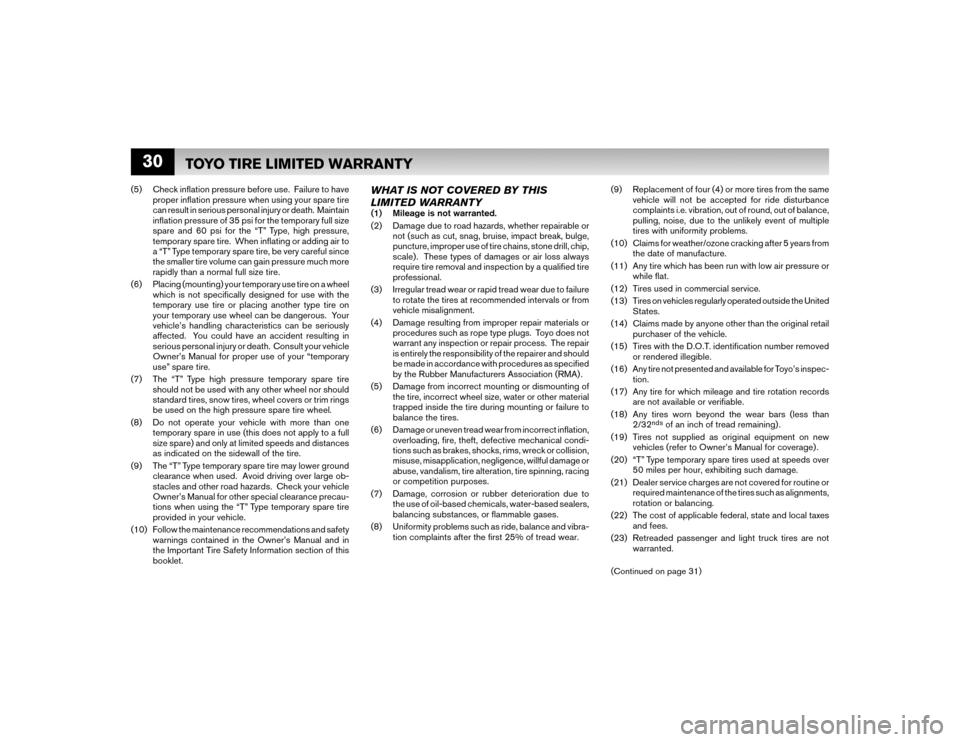
30
(9) Replacement of four (4) or more tires from the same
vehicle will not be accepted for ride disturbance
complaints i.e. vibration, out of round, out of balance,
pulling, noise, due to the unlikely event of multiple
tires with uniformity problems.
(10) Claims for weather/ozone cracking after 5 years from
the date of manufacture.
(11) Any tire which has been run with low air pressure or
while fl at.
(12) Tires used in commercial service.
(13) Tires on vehicles regularly operated outside the United
States.
(14) Claims made by anyone other than the original retail
purchaser of the vehicle.
(15) Tires with the D.O.T. identifi cation number removed
or rendered illegible.
(16) Any tire not presented and available for Toyo’s inspec-
tion.
(17) Any tire for which mileage and tire rotation records
are not available or verifi able.
(18) Any tires worn beyond the wear bars (less than
2/32
nds of an inch of tread remaining) .
(19) Tires not supplied as original equipment on new
vehicles (refer to Owner’s Manual for coverage) .
(20) “T” Type temporary spare tires used at speeds over
50 miles per hour, exhibiting such damage.
(21) Dealer service charges are not covered for routine or
required maintenance of the tires such as alignments,
rotation or balancing.
(22) The cost of applicable federal, state and local taxes
and fees.
(23) Retreaded passenger and light truck tires are not
warranted.
TOYO TIRE LIMITED WARRANTY
(5) Check infl ation pressure before use. Failure to have
proper infl ation pressure when using your spare tire
can result in serious personal injury or death. Maintain
infl ation pressure of 35 psi for the temporary full size
spare and 60 psi for the “T” Type, high pressure,
temporary spare tire. When infl ating or adding air to
a “T” Type temporary spare tire, be very careful since
the smaller tire volume can gain pressure much more
rapidly than a normal full size tire.
(6) Placing (mounting) your temporary use tire on a wheel
which is not specifi cally designed for use with the
temporary use tire or placing another type tire on
your temporary use wheel can be dangerous. Your
vehicle’s handling characteristics can be seriously
affected. You could have an accident resulting in
serious personal injury or death. Consult your vehicle
Owner’s Manual for proper use of your “temporary
use” spare tire.
(7) The “T” Type high pressure temporary spare tire
should not be used with any other wheel nor should
standard tires, snow tires, wheel covers or trim rings
be used on the high pressure spare tire wheel.
(8) Do not operate your vehicle with more than one
temporary spare in use (this does not apply to a full
size spare) and only at limited speeds and distances
as indicated on the sidewall of the tire.
(9) The “T” Type temporary spare tire may lower ground
clearance when used. Avoid driving over large ob-
stacles and other road hazards. Check your vehicle
Owner’s Manual for other special clearance precau-
tions when using the “T” Type temporary spare tire
provided in your vehicle.
(10) Follow the maintenance recommendations and safety
warnings contained in the Owner’s Manual and in
the Important Tire Safety Information section of this
booklet.
WHAT IS NOT COVERED BY THIS
LIMITED WARRANTY(1) Mileage is not warranted.
(2) Damage due to road hazards, whether repairable or
not (such as cut, snag, bruise, impact break, bulge,
puncture, improper use of tire chains, stone drill, chip,
scale) . These types of damages or air loss always
require tire removal and inspection by a qualifi ed tire
professional.
(3) Irregular tread wear or rapid tread wear due to failure
to rotate the tires at recommended intervals or from
vehicle misalignment.
(4) Damage resulting from improper repair materials or
procedures such as rope type plugs. Toyo does not
warrant any inspection or repair process. The repair
is entirely the responsibility of the repairer and should
be made in accordance with procedures as specifi ed
by the Rubber Manufacturers Association (RMA) .
(5) Damage from incorrect mounting or dismounting of
the tire, incorrect wheel size, water or other material
trapped inside the tire during mounting or failure to
balance the tires.
(6) Damage or uneven tread wear from incorrect infl ation,
overloading, fi re, theft, defective mechanical condi-
tions such as brakes, shocks, rims, wreck or collision,
misuse, misapplication, negligence, willful damage or
abuse, vandalism, tire alteration, tire spinning, racing
or competition purposes.
(7) Damage, corrosion or rubber deterioration due to
the use of oil-based chemicals, water-based sealers,
balancing substances, or fl ammable gases.
(8) Uniformity problems such as ride, balance and vibra-
tion complaints after the fi rst 25% of tread wear.
(Continued on page 31)
Page 36 of 55
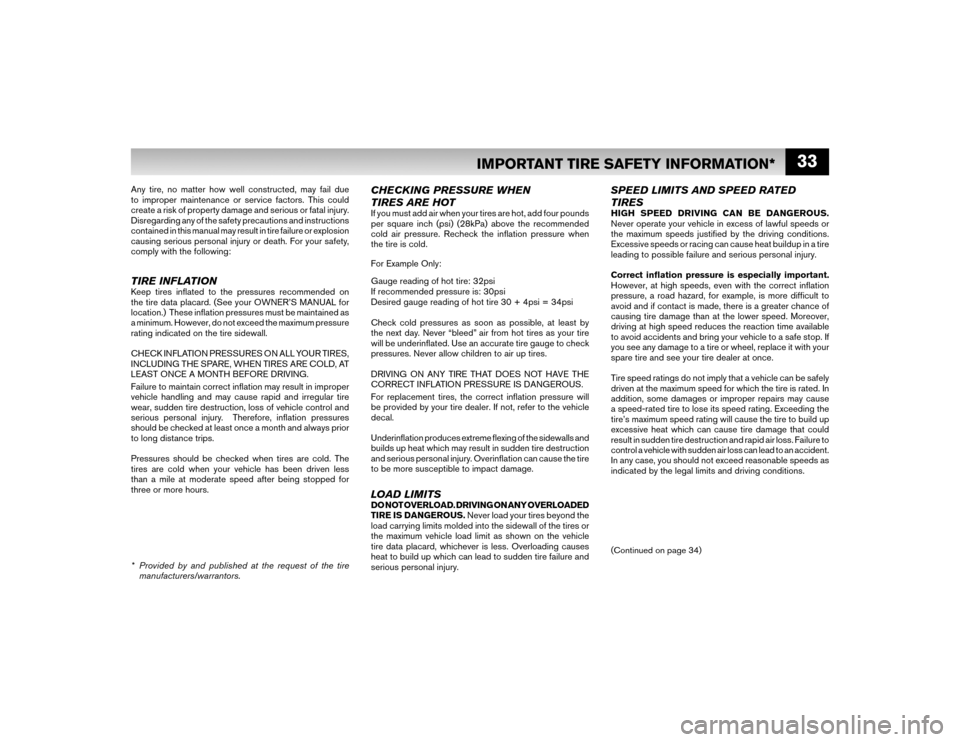
33
Any tire, no matter how well constructed, may fail due
to improper maintenance or service factors. This could
create a risk of property damage and serious or fatal injury.
Disregarding any of the safety precautions and instructions
contained in this manual may result in tire failure or explosion
causing serious personal injury or death. For your safety,
comply with the following:TIRE INFLATIONKeep tires infl ated to the pressures recommended on
the tire data placard. (See your OWNER’S MANUAL for
location.) These infl ation pressures must be maintained as
a minimum. However, do not exceed the maximum pressure
rating indicated on the tire sidewall.
CHECK INFLATION PRESSURES ON ALL YOUR TIRES,
INCLUDING THE SPARE, WHEN TIRES ARE COLD, AT
LEAST ONCE A MONTH BEFORE DRIVING.
Failure to maintain correct infl ation may result in improper
vehicle handling and may cause rapid and irregular tire
wear, sudden tire destruction, loss of vehicle control and
serious personal injury. Therefore, infl ation pressures
should be checked at least once a month and always prior
to long distance trips.
Pressures should be checked when tires are cold. The
tires are cold when your vehicle has been driven less
than a mile at moderate speed after being stopped for
three or more hours.
CHECKING PRESSURE WHEN
TIRES ARE HOTIf you must add air when your tires are hot, add four pounds
per square inch (psi) (28kPa) above the recommended
cold air pressure. Recheck the infl ation pressure when
the tire is cold.
For Example Only:
Gauge reading of hot tire: 32psi
If recommended pressure is: 30psi
Desired gauge reading of hot tire 30 + 4psi = 34psi
Check cold pressures as soon as possible, at least by
the next day. Never “bleed” air from hot tires as your tire
will be underinfl ated. Use an accurate tire gauge to check
pressures. Never allow children to air up tires.
DRIVING ON ANY TIRE THAT DOES NOT HAVE THE
CORRECT INFLATION PRESSURE IS DANGEROUS.
For replacement tires, the correct infl ation pressure will
be provided by your tire dealer. If not, refer to the vehicle
decal.
Underinfl ation produces extreme fl exing of the sidewalls and
builds up heat which may result in sudden tire destruction
and serious personal injury. Overinfl ation can cause the tire
to be more susceptible to impact damage.LOAD LIMITSDO NOT OVERLOAD. DRIVING ON ANY OVERLOADED
TIRE IS DANGEROUS. Never load your tires beyond the
load carrying limits molded into the sidewall of the tires or
the maximum vehicle load limit as shown on the vehicle
tire data placard, whichever is less. Overloading causes
heat to build up which can lead to sudden tire failure and
serious personal injury.
SPEED LIMITS AND SPEED RATED
TIRESHIGH SPEED DRIVING CAN BE DANGEROUS.
Never operate your vehicle in excess of lawful speeds or
the maximum speeds justifi ed by the driving conditions.
Excessive speeds or racing can cause heat buildup in a tire
leading to possible failure and serious personal injury.
Correct infl ation pressure is especially important.
However, at high speeds, even with the correct infl ation
pressure, a road hazard, for example, is more diffi cult to
avoid and if contact is made, there is a greater chance of
causing tire damage than at the lower speed. Moreover,
driving at high speed reduces the reaction time available
to avoid accidents and bring your vehicle to a safe stop. If
you see any damage to a tire or wheel, replace it with your
spare tire and see your tire dealer at once.
Tire speed ratings do not imply that a vehicle can be safely
driven at the maximum speed for which the tire is rated. In
addition, some damages or improper repairs may cause
a speed-rated tire to lose its speed rating. Exceeding the
tire’s maximum speed rating will cause the tire to build up
excessive heat which can cause tire damage that could
result in sudden tire destruction and rapid air loss. Failure to
control a vehicle with sudden air loss can lead to an accident.
In any case, you should not exceed reasonable speeds as
indicated by the legal limits and driving conditions.
* Provided by and published at the request of the tire
manufacturers/warrantors.
IMPORTANT TIRE SAFETY INFORMATION*
(Continued on page 34)
Page 37 of 55
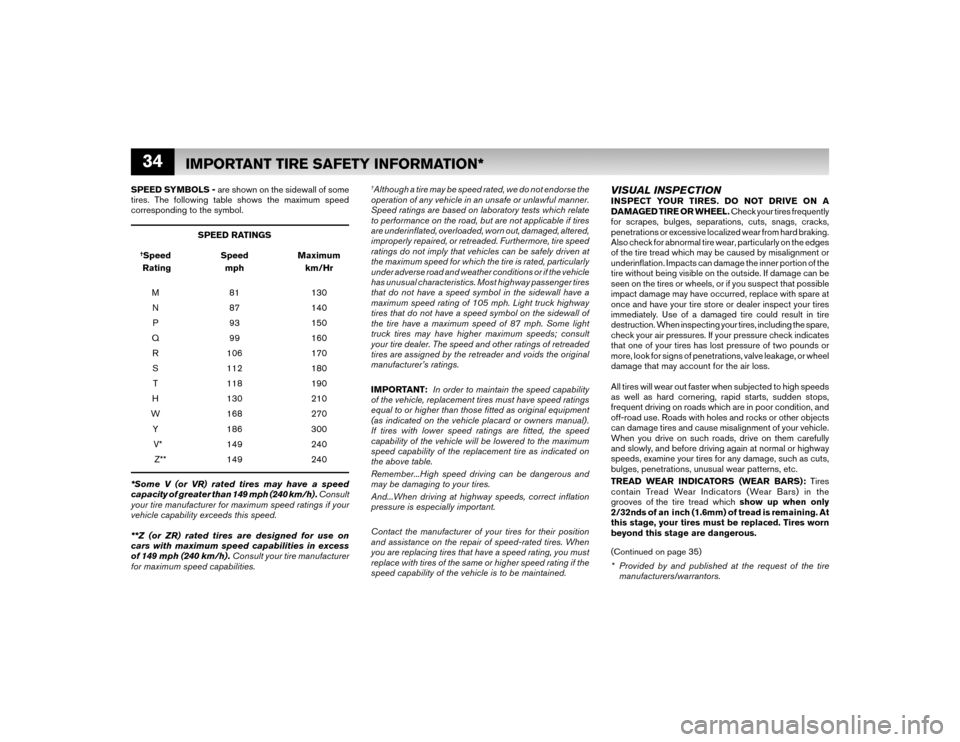
34SPEED SYMBOLS - are shown on the sidewall of some
tires. The following table shows the maximum speed
corresponding to the symbol.
SPEED RATINGS †
Speed Speed Maximum
Rating mph km/Hr
M 81 130
N 87 140
P 93 150
Q 99 160
R 106 170
S 112 180
T 118 190
H 130 210
W 168 270
Y 186 300
V* 149 240
Z** 149 240
*Some V (or VR) rated tires may have a speed
capacity of greater than 149 mph (240 km/h) . Consult
your tire manufacturer for maximum speed ratings if your
vehicle capability exceeds this speed.
**Z (or ZR) rated tires are designed for use on
cars with maximum speed capabilities in excess
of 149 mph (240 km/h) . Consult your tire manufacturer
for maximum speed capabilities.
†Although a tire may be speed rated, we do not endorse the
operation of any vehicle in an unsafe or unlawful manner.
Speed ratings are based on laboratory tests which relate
to performance on the road, but are not applicable if tires
are underinfl ated, overloaded, worn out, damaged, altered,
improperly repaired, or retreaded. Furthermore, tire speed
ratings do not imply that vehicles can be safely driven at
the maximum speed for which the tire is rated, particularly
under adverse road and weather conditions or if the vehicle
has unusual characteristics. Most highway passenger tires
that do not have a speed symbol in the sidewall have a
maximum speed rating of 105 mph. Light truck highway
tires that do not have a speed symbol on the sidewall of
the tire have a maximum speed of 87 mph. Some light
truck tires may have higher maximum speeds; consult
your tire dealer. The speed and other ratings of retreaded
tires are assigned by the retreader and voids the original
manufacturer’s ratings.
IMPORTANT: In order to maintain the speed capability
of the vehicle, replacement tires must have speed ratings
equal to or higher than those fi tted as original equipment
(as indicated on the vehicle placard or owners manual) .
If tires with lower speed ratings are fi tted, the speed
capability of the vehicle will be lowered to the maximum
speed capability of the replacement tire as indicated on
the above table.
Remember...High speed driving can be dangerous and
may be damaging to your tires.
And...When driving at highway speeds, correct infl ation
pressure is especially important.
Contact the manufacturer of your tires for their position
and assistance on the repair of speed-rated tires. When
you are replacing tires that have a speed rating, you must
replace with tires of the same or higher speed rating if the
speed capability of the vehicle is to be maintained.
VISUAL INSPECTIONINSPECT YOUR TIRES. DO NOT DRIVE ON A
DAMAGED TIRE OR WHEEL. Check your tires frequently
for scrapes, bulges, separations, cuts, snags, cracks,
penetrations or excessive localized wear from hard braking.
Also check for abnormal tire wear, particularly on the edges
of the tire tread which may be caused by misalignment or
underinfl ation. Impacts can damage the inner portion of the
tire without being visible on the outside. If damage can be
seen on the tires or wheels, or if you suspect that possible
impact damage may have occurred, replace with spare at
once and have your tire store or dealer inspect your tires
immediately. Use of a damaged tire could result in tire
destruction. When inspecting your tires, including the spare,
check your air pressures. If your pressure check indicates
that one of your tires has lost pressure of two pounds or
more, look for signs of penetrations, valve leakage, or wheel
damage that may account for the air loss.
All tires will wear out faster when subjected to high speeds
as well as hard cornering, rapid starts, sudden stops,
frequent driving on roads which are in poor condition, and
off-road use. Roads with holes and rocks or other objects
can damage tires and cause misalignment of your vehicle.
When you drive on such roads, drive on them carefully
and slowly, and before driving again at normal or highway
speeds, examine your tires for any damage, such as cuts,
bulges, penetrations, unusual wear patterns, etc.
TREAD WEAR INDICATORS (WEAR BARS): Tires
contain Tread Wear Indicators (Wear Bars) in the
grooves of the tire tread which show up when only
2/32nds of an inch (1.6mm) of tread is remaining. At
this stage, your tires must be replaced. Tires worn
beyond this stage are dangerous.
* Provided by and published at the request of the tire
manufacturers/warrantors.
IMPORTANT TIRE SAFETY INFORMATION*
(Continued on page 35)
Page 38 of 55
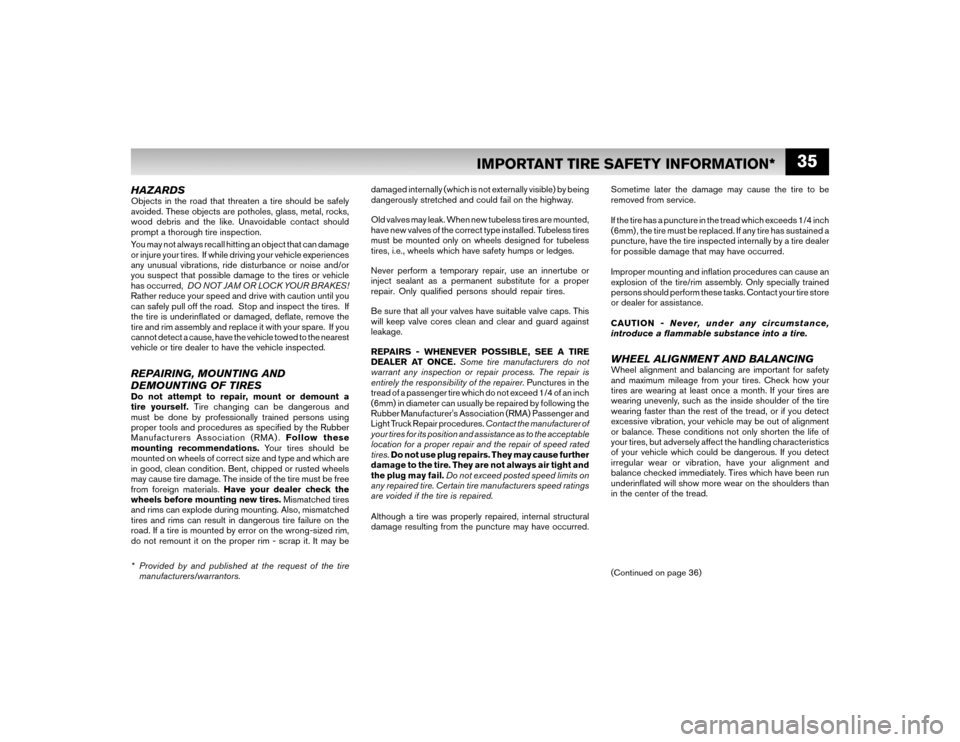
35
HAZARDSObjects in the road that threaten a tire should be safely
avoided. These objects are potholes, glass, metal, rocks,
wood debris and the like. Unavoidable contact should
prompt a thorough tire inspection.
You may not always recall hitting an object that can damage
or injure your tires. If while driving your vehicle experiences
any unusual vibrations, ride disturbance or noise and/or
you suspect that possible damage to the tires or vehicle
has occurred, DO NOT JAM OR LOCK YOUR BRAKES!
Rather reduce your speed and drive with caution until you
can safely pull off the road. Stop and inspect the tires. If
the tire is underinfl ated or damaged, defl ate, remove the
tire and rim assembly and replace it with your spare. If you
cannot detect a cause, have the vehicle towed to the nearest
vehicle or tire dealer to have the vehicle inspected.REPAIRING, MOUNTING AND
DEMOUNTING OF TIRESDo not attempt to repair, mount or demount a
tire yourself. Tire changing can be dangerous and
must be done by professionally trained persons using
proper tools and procedures as specifi ed by the Rubber
Manufacturers Association (RMA) . Follow these
mounting recommendations. Your tires should be
mounted on wheels of correct size and type and which are
in good, clean condition. Bent, chipped or rusted wheels
may cause tire damage. The inside of the tire must be free
from foreign materials. Have your dealer check the
wheels before mounting new tires. Mismatched tires
and rims can explode during mounting. Also, mismatched
tires and rims can result in dangerous tire failure on the
road. If a tire is mounted by error on the wrong-sized rim,
do not remount it on the proper rim - scrap it. It may be damaged internally (which is not externally visible) by being
dangerously stretched and could fail on the highway.
Old valves may leak. When new tubeless tires are mounted,
have new valves of the correct type installed. Tubeless tires
must be mounted only on wheels designed for tubeless
tires, i.e., wheels which have safety humps or ledges.
Never perform a temporary repair, use an innertube or
inject sealant as a permanent substitute for a proper
repair. Only qualifi ed persons should repair tires.
Be sure that all your valves have suitable valve caps. This
will keep valve cores clean and clear and guard against
leakage.
REPAIRS - WHENEVER POSSIBLE, SEE A TIRE
DEALER AT ONCE. Some tire manufacturers do not
warrant any inspection or repair process. The repair is
entirely the responsibility of the repairer. Punctures in the
tread of a passenger tire which do not exceed 1/4 of an inch
(6mm) in diameter can usually be repaired by following the
Rubber Manufacturer's Association (RMA) Passenger and
Light Truck Repair procedures. Contact the manufacturer of
your tires for its position and assistance as to the acceptable
location for a proper repair and the repair of speed rated
tires. Do not use plug repairs. They may cause further
damage to the tire. They are not always air tight and
the plug may fail. Do not exceed posted speed limits on
any repaired tire. Certain tire manufacturers speed ratings
are voided if the tire is repaired.
Although a tire was properly repaired, internal structural
damage resulting from the puncture may have occurred. Sometime later the damage may cause the tire to be
removed from service.
If the tire has a puncture in the tread which exceeds 1/4 inch
(6mm) , the tire must be replaced. If any tire has sustained a
puncture, have the tire inspected internally by a tire dealer
for possible damage that may have occurred.
Improper mounting and infl ation procedures can cause an
explosion of the tire/rim assembly. Only specially trained
persons should perform these tasks. Contact your tire store
or dealer for assistance.
CAUTION - Never, under any circumstance,
introduce a fl ammable substance into a tire.
WHEEL ALIGNMENT AND BALANCINGWheel alignment and balancing are important for safety
and maximum mileage from your tires. Check how your
tires are wearing at least once a month. If your tires are
wearing unevenly, such as the inside shoulder of the tire
wearing faster than the rest of the tread, or if you detect
excessive vibration, your vehicle may be out of alignment
or balance. These conditions not only shorten the life of
your tires, but adversely affect the handling characteristics
of your vehicle which could be dangerous. If you detect
irregular wear or vibration, have your alignment and
balance checked immediately. Tires which have been run
underinfl ated will show more wear on the shoulders than
in the center of the tread.
* Provided by and published at the request of the tire
manufacturers/warrantors.
IMPORTANT TIRE SAFETY INFORMATION*
(Continued on page 36)